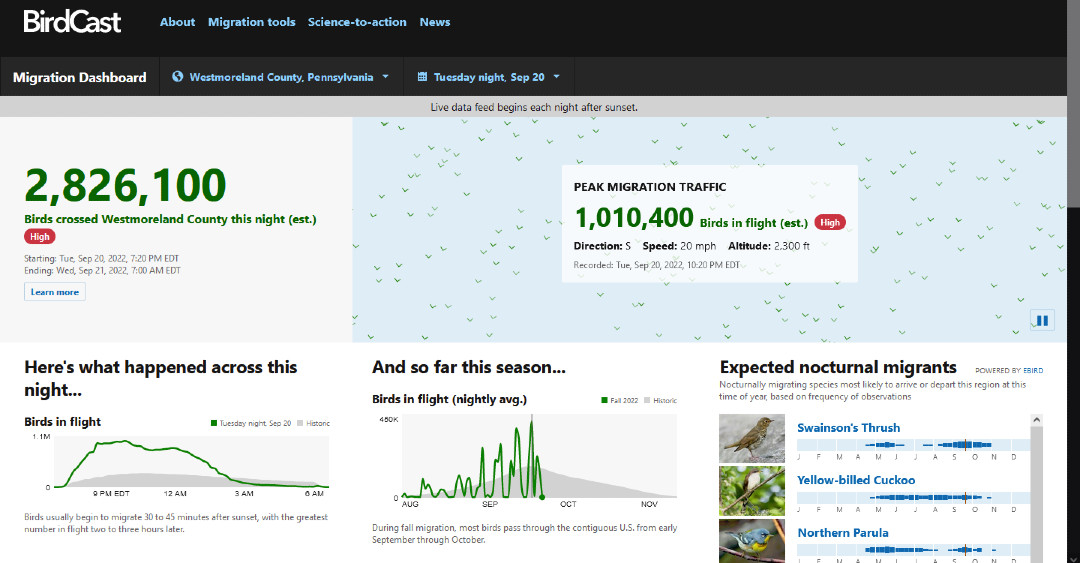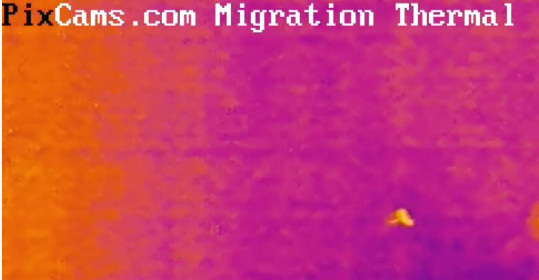
The Migrating Birds Overhead
Jim Kellam, PhD. Associate Professor of Biology
Saint Vincent College
Anyone who lives in western Pennsylvania can tell you that not only has astronomical autumn come upon us, so too has the autumn weather. I love this season! In the bird world we are monitoring large numbers of migrating birds as they fly south for the winter. PixCams is keeping track of this with our Live Bird Migration Station. The video footage from the thermal camera is especially fascinating to watch, and I think we are collecting some really important data. But alas, another thing that happens in fall is my busyness as a college biology professor. The freshman introductory course I teach is always time-intensive and stressful for both me and my students. Therefore, I am resigned to just watching the birds migrate this season without doing any scientific analysis. And that’s okay. You and I both can watch the footage and delight in seeing birds fly singly or with companions; fly high overhead or low to the ground; flap a lot or flap a little; fly in a straight direction or one more uncertain. The thermal camera technology itself is a wonder—without it we wouldn’t necessarily realize how much heat a bird generates. When I band nestling or adult birds in my hand, I can feel their warmth and smell the humidity of the air trapped within their feathers. But with the thermal camera we can see this heat and appreciate the vitality it signals. These birds are alive. These birds can fly with their own bodies and choose where to go and how high to be. These migrating birds are in the midst of an endurance race longer than the Ironman Triathlons I have done. These birds will see more of the world than I, within a much shorter lifetime.
From my busy-professor armchair perch, let me tell you some other things about migrating birds.
- 70% of the world’s bird species migrate. Of course, that means 30% do not, so there will be plenty left to visit PixCam’s bird feeding stations this winter.
- There are many kinds of migration strategies. Some birds just fly up and down mountain sides each year (altitudinal migrants), some don’t have specific winter destinations in mind (nomadic migrants), and some migrate only when the weather turns bad or when the lakes freeze over or when food runs out (facultative migrant). The best known migrants are the ones that arrive and leave like clockwork, and they usually return to the same places in summer and winter. This kind of migrant has the behavior genetically programmed into their brains and bodies, and so incidentally, they are the ones most at risk from human-caused climate change, since they cannot adjust to change quickly.
- Birds use a variety of cues to help them navigate. They don’t have smart phones, so Google Maps can’t be used. Instead, they follow mountain ridges, coastlines, and other landscape features they can see. Birds might also use a magnetic sense in the same way, since certain landmasses like hills or islands alter the Earth’s magnetic field. The magnetic field changes with latitude, too, so birds can know how far they have traveled and in what direction. Some species are known to use smell to locate home, and use various ocean odors as landmarks along the way. There is even the possibility that birds might use low-frequency sounds like waves crashing along the coast to help birds determine their position, even when the coastline is beyond the horizon. There are other senses birds can use for navigation, but this post is already getting on the lengthy side, so I’ll end with just one more: the stars. That’s right; birds use constellations to navigate while migrating at night.
- Let me say that again—birds migrate at night! There are plenty of examples of birds migrating during the day, but nocturnal migration is very, very common. There’s a good reason for this: flying 100 miles or more every night burns vast sums of energy, and birds must use the daylight to search for and consume food to fill their tanks.
- That leads me to another important aspect of migratory behavior: the weather strongly affects the distances traveled each day or night, in at least three ways. First, if the weather is poor during the day when the birds are searching for food, they may not be able to accumulate enough fat to fuel a full night of travel. The birds may then decide to stay in place for an extra day or more to acquire additional food. Second, even if birds were successful in finding food one day, they may not take off at night if the wind direction and speed will hamper their flight. It takes extra energy to fly against the wind (a headwind), so for birds traveling south in fall, they might skip a night of migration if the prevailing winds are from the south. Finally, storms are bad. If you’ve ever had an airplane flight delayed due to weather, you can relate.
- Migrations are very dangerous. Birds have to stop at locations along their flightpath, and these spots are not always safe for birds. They may harbor unfamiliar predators, they may have unpredictable food supplies, and unforeseen human disturbance or natural disasters may have destroyed the favored habitat they last visited months ago on their previous migratory flight. There is also a large amount of mortality associated with birds being attracted to urban lights at night as they fly. Nevertheless, migration has evolved in a large number of species, which means in the long run, migration has been better for survival than the alternative. The lack of food in winter is what forces these species to move south.
The BirdCast website is a great tool to use to see real data on the migratory activity overhead each night. The photo posted here is a screenshot of BirdCast’s Migration Dashboard. After selecting a location relevant to you (I live in Westmoreland County, Pennsylvania), you can select a date of interest. I chose the night starting on September 20, 2022, because that appears to have been when bird migration peaked this season. Indeed, Birdcast estimated that 2,826,100 individual birds flew over Westmoreland County that night. How can this be known? The answer is weather radar. If radar is sensitive enough to detect water droplets in clouds (it is!), then it can certainly detect larger things in the air like birds. Researchers have been using weather radar to study migrating birds for many decades now.
Based on the radar signatures, Birdcast can calculate the direction, speed, and altitude of the birds detected with every sweep. On September 20th, most birds were traveling south at 20 mph at an altitude of 2,300 feet above ground level. The greatest number of migrants detected in the air over my county at any one time was at 10:20 pm, when about 1 million birds were present. This was well above the 300,000 mark that is usually detected on this date in previous years. In the panel at bottom left, you can see how the green line (data from the 20th) compares to the historic average (gray line) compiled over many years on the same date. As a scientist, I can tell you that averages are rather useless when there is a large amount of variation from one night to another, and that is illustrated in the bottom-center panel. Do you see how the green line goes up and down for each day? On some days there is a massive number of birds in the skies, and on other days there are hardly any. This pattern is strongly related to weather conditions like wind direction and storm systems, though there may be other reasons for the variation that we don’t know much about. On Sept 20th for example, the hourly weather conditions at Latrobe Regional Airport showed the wind was calm overnight and skies were clear. In contrast, one night later on September 21st, the wind was from the south around 15 mph with gusts up to 24 mph. Skies were still fair, but that wind certainly kept birds grounded. Birdcast estimated that only 23,500 birds passed overhead on the 21st in contrast to the 2.8 million estimated the night before.
In the right panel of the Birdcast screen is a list of bird species. These are the species that may be migrating the most on the selected night. It’s a useful thing to know, but what I wish the BirdCast report would make clear is the fact that the radar data does not identify the species in the air. The species list is instead assumed from daytime sightings made by citizen scientists through eBird.org, summed over many years for the date in question. It’s the equivalent of calculating the “average” bird’s identity based on previous years’ data, and therefore is subject to wild variations from night to night. Maybe one day systems like ours at PixCams will be able to make real-time identifications of those super-heated, super-hero, flapping silhouettes that we see today in our thermal camera videos. Stay tuned.


Thanks for sharing. I read many of your blog posts, cool, your blog is very good.